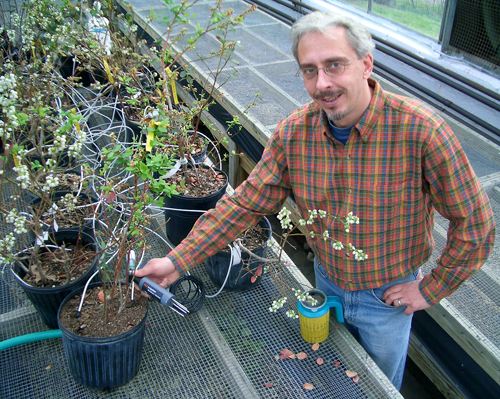How or when to water plants in a greenhouse or at a nursery is largely based on experience – a finger poke in the soil or simply a watering tradition passed from one worker to the next – or, it’s just plain guesswork. No one’s ever thought to ask the plants how much water they really need.
A project being conducted by the University of Georgia College of Agricultural and Environmental Sciences and several Georgia nurseries is doing just that. And the information is saving water, fertilizer and time.
Using wireless sensors and computer software, CAES horticulturists are measuring soil moisture around plant roots. When the water levels get low, the sensors send information to a grower’s computer. Sound watering decision can then be made.
“When it was hotter outside, I loved being able to come into the office early in the morning and download the data,” said Will Ross with Evergreen Nursery in Statham, Ga. “I could know without even going outside what the watering needs were. It helped a lot.”
Ross likes to test his personal skills at determining how much water his plants need against the computer data. “As a grower, it kind of gives me extra confidence that I can tell when plants don’t need water and when they do,” he said.
CAES associate professor Marc van Iersel started using soil sensors in his greenhouse six years ago. Evergreen Nursery, McCorkle Nurseries in Dearing, Ga., and other U.S. nurseries have tested the sensors and computer software for the past year.
“The technology is pretty easy to use,” van Iersel said. “Much of it is plug and play. You plug a sensor into the datalogger. There’s no wiring. You tell the computer which plants are using the sensors. And it’s going to become easier with updated software that’s coming out soon.”
More than water savings
Regardless of drought or rain, less water used at a nursery means more in the reservoir and money saved by growers.
Watering according to a plant’s needs “should minimize disease pressure to a great degree and allow us to use a reduced rate of fertilizer, which saves costs to growers and prevents potential runoff issues associated with that,” said Chris McCorkle of McCorkle Nurseries. “And, ultimately, it will help us improve plant quality.”
It seems like plant quality would improve with more water and fertilizer, but too much of either can lead to stressed – and possibly diseased – plants that aren’t as well prepared to grow outside a greenhouse or nursery.
Scaled to needs
The UGA researchers developed the monitoring system to scale to any operation, and be affordable. “The nice thing about the system is that you’re able to start with small sections and let it grow over time,” Van Iersel said.
“I think if we go through this trial, and we see multiple benefits to this,” the system’s cost “is just a hurdle we’d have to jump,” Ross said. “I maybe wouldn’t take on the whole nursery at one time.”
Next step
Nursery growers are giving UGA CAES horticulturists feedback on how the monitoring system will help in the long run.
“It’s exciting to see this kind of technology being applied in a production environment,” said Chris Butts with the Georgia Green Industry Association. “So far, it looks promising. I’m glad we have growers excited about the potential of the technology.”
UGA is working with Carnegie-Mellon University, where researchers are developing new hardware that automatically turns irrigation on or off as needed. Van Iersel hopes to have prototypes this spring to install in the nurseries.
“A system like this is ultimately going to make better decisions than many of our irrigation guys are going to make,” McCorkle said. “Having a system like this could greatly improve our watering situation.”











